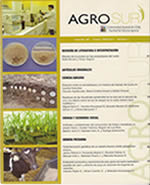Temo-Pitra Forest in the intermediate depression of the Los Ríos Region (Chile): Classification, management and degradation of flora and vegetation
Main Article Content
Abstract
Temo-Pitra Forest swamps represent one of the most important habitats for the Huillín (Lontra provocax), a riverine otter native from south-central Chile. Remnant stands of these forests are currently coexisting with other plant communities due to the growing anthropogenic disturbance by livestock husbandry and grazing. In order to characterise the floristic composition and vegetation structure we studied the Millahuillín wetland located near Máfil, province of Valdivia, Región de Los Ríos, Chile. The plants were sampled with phytosociological methodology using 51 samples. A total of 97 plant species were determined, 52 were native and 45 introduced. Five plant associations were determined, namely the Temo-Pitra Forest (Blepharocalyo-Myrceugenietum exsuccae), Zarzamora- Quilquil scrub (Rubo-Blechnetum chilensii), Cortadera reeds (Loto pedunculati-Cyperetum eragrostis), Junquillo grassland (Juncetum procerii) and Chépica prairie (Loto pedunculati-Agrostietum capillaris), from which only the forest represents the pristine vegetations, while the rest are secondary and tertiary succession stages. We concluded that the flora and plant vegetation biodiversity of the place has increased, but almost all the newcomers are introduced species. Furthermore, the plant associations that replaced the primitive ones are much lower in height and totally change the landscape, which can no longer serve as a safe habitat exposed to light. This dramatic change in the landscape restrict the function of the vegetation as a suitable habitat for Lontra provocax.

